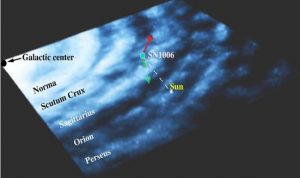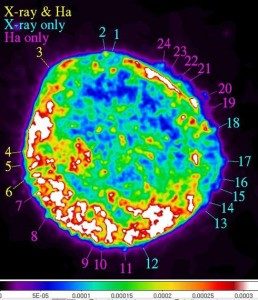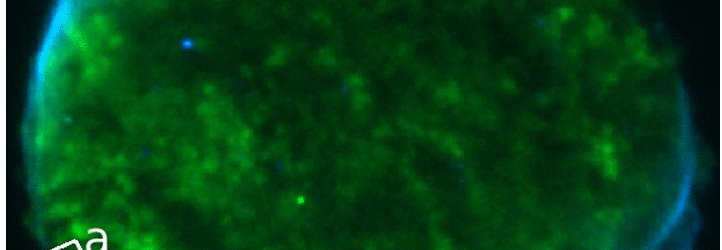Cosmic rays, supernova remnants and their interactions with the surrounding enviroments
Cosmic rays
Cosmic rays are energetic particles which arrives at Earth from the space, carrying information about their source and path they travelled. Unveiling this information is one of the most challenging task in astrophysics, still on the leading edge after a century from their discovery by Hess in 1912. While most of the astrophysics studies are performed by collecting photons arriving from extraterrestrial sources, cosmic rays represent an complementary window to the universe. Being mostly composed of charged particles, cosmic rays are very sensitive to magnetic fields throughout all their journey, from the origin to the detection on the Earth. This makes them one of the primary way trough which the magnetic fields can be measured on some astrophysical sources, and in the Galaxy plane, where they spend part of their journey. Among the most important open issues about cosmic rays, there is the still unsettled debate about their origin. While for the high energy part of their spectrum (above particle energy of 10^15 eV) the core of active galactic nuclei seems to be the most promising candidate, for their low energy part the strong shock waves of supernova remnants seems to satisfy the energetic requirements.
At the Palermo Astronomical Observatory, we are working on both observations and models of supernova remnant accelerating cosmic rays. Our primary goal is to understand if the classical Diffusive Shock Acceleration model and its non-linear extension can reproduce the observations in radio, X-rays and gamma rays of galactic supernova remnants. Current and future directions include the modeling and the observations of oblique shocks, of the effects of cosmic rays modification of the shock thermal structure and the study of radiative shocks.

An artist view of the Galaxy and the location of the remnant of the historical supernova SN1006. The red arrow indicates the direction of galactic magnetic field at the location of SN1006, as deduced by the comparison of the observations of the remnant with a 3-D magneto-hydrodynamical model developed by our group. The green arrow marks the direction of the gradient of the magnetic field required to explain the observations, pointing quite naturally toward the Galactic plane (Bocchino et al. 2011)
Supernova remnants
Supernovae explosions are the final phase of the life of stars a lot more massive than the Sun. During the convulsive phases preceding the explosion, stars reach very high temperatures (tens and hundreds of million degrees) and nuclear fusion reactions take place, leading to the formation of carbon, nitrogen, oxygen, neon, magnesium, silicon, sulphur, iron from simpler elements such as hydrogen and helium. The conditions for the formation of such elements, essential to life, are present only inside supernovae. During the explosion, these newly formed elements are ejected into the inter-stellar space and enlarge the clouds and the nebulae, whose gravitational collapse will originate new stars and planets. Our existence thus depends on this fascinating astrophysical process. Without it, the Universe could not enjoy the huge variety of chemicals it currently owns.
The X-ray band is one of the most suitable means for studying the remnants of supernovae explosions. The resulting giant shockwave heats the stellar remnants and the interstellar medium up to some million degrees; being matter at this temperature turned into plasma, it emits X-rays, which can be observed with the appropriate telescopes. So it becomes possible to study the distribution and chemical composition of star fragments and inter-stellar medium, and obtain valuable data on the formation and distribution processes of the chemicals produced by supernovae. Where absorption is not an issue, optical spectrophotometry can be used to derive additional constrains on the chemical and thermal structures of the shocked plasma. Recently, the availability of gamma-ray observations in the GeV-TeV regimes by the AGILE, FERMI and Cherenkov Telescopes (e.g. HESS) have opened the possibility to study the spectral energy distribution of supernova remnants from radio to very high energies, which may give additional constraints on the acceleration physics and on the interaction with the environment.
In the Observatory of Palermo a few research programs are investigating some puzzling morphological issues of supernova remnant, like the new and still unexplored class of mixed-morphology remnants and the spatial structures of X-ray knots in historical SN remnants. Future directions include the modeling and observations of overionized plasma (whose origin is still under debate) and the study of ejecta clumping as a probe for the initial conditions in a SN explosions. These studies will be carried out using both observations and numerical simulations (see the Section Computational Fluid Dynamics for Astrophysical Plasmas).

An XMM-Newton mosaic of the remnant of SN1006 in the X-ray band of the prominent oxygen lines emission (0.5-0.8 keV). Numbers mark the position of ejecta fragments protruding outside the main shock front. The study of the protrusions offers an insight on the star layers at the time of the explosions, opening up the possibility to study the property of the supernova looking at its remnant.
About the group
The supernova remnant group at the Palermo Astronomical Observatory has a strong background in data reduction and analysis of high energy data. We are PI or CoI of several observational programs of X-ray astronomy missions, like XMM-Newton, Chandra, Suzaku, INTEGRAL. In the recent years, the group has acquired a consistent background in the field of 3-D magneto-hydrodynamical models of supernova remnants. In particular we have studied the effects of physical effects like radiative losses, thermal conduction, and non-equilibrium of ionization on the expected high energy emission, while, more recently, the group has worked to include the effects of cosmic ray acceleration in our MHD models. The group has also well-developed network of international collaborations. We offer a very friendly and stimulating environment for scientific research, full library access (both electronic and paper version), and state-of-the-art computing and network resources, both for data analysis and numerical simulations. Last but not least, we are located in the lively historical center of Palermo, a destination of the international tourism, with a mild climate and well-known appreciated cuisine.
Involved people:
- Fabrizio Bocchino – bocchino at astropa.inaf.it
- Marco Miceli – miceli at astropa.unipa.it
- Salvatore Orlando – orlando at astropa.inaf.it
- Fabio Reale – reale at astropa.astropa.it
Other research activities
- Stellar magnetic activity
- Physics of the sun outer atmosphere
- Star formation and evolution in the galaxy
- Exoplanets (EXOPA Team)
- Experimental astrobiology
- Development of instruments for space-based astronomy
- Computational fluid dynamics for astrophysical plasma and high performance computing
- History of Astronomy
